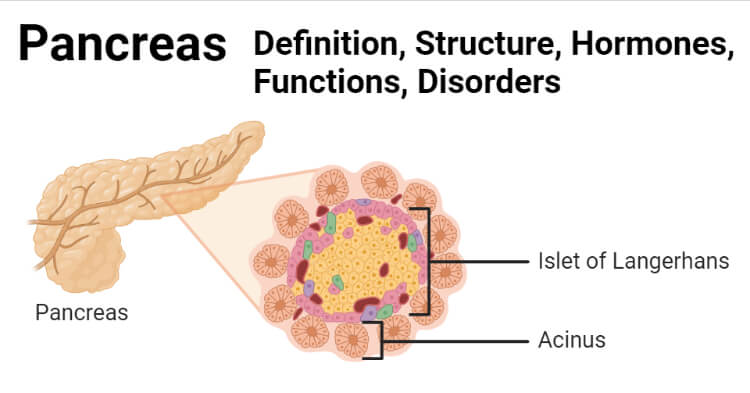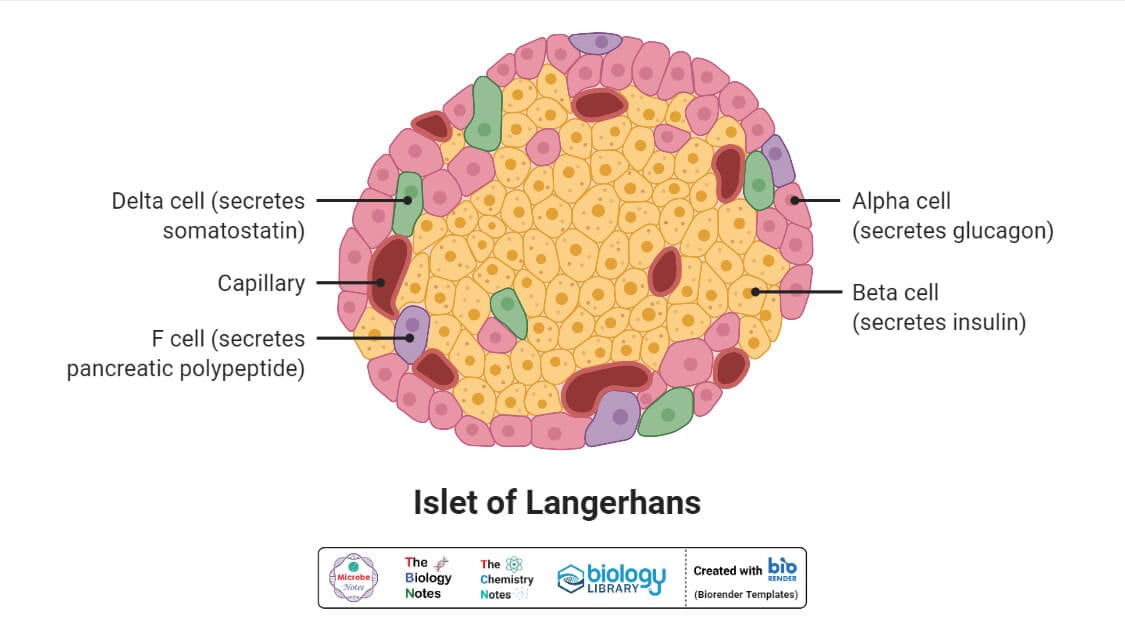The pancreas is a complex organ consisting of both exocrine and endocrine areas where the endocrine part is composed of discrete islets of Langerhans that secrete numerous hormones.
- The studies related to the Islets of Langerhans have increased over the years due to the involvement of the cells in diabetes.
- The islets composed of a few thousand endocrine cells account for about 2% of the total pancreatic mass.
- The primary function of the endocrine region of the pancreas is to assist digestion by the release of hormones that help in the metabolism of different biomolecules.
- The pancreas is located behind the stomach as a soft tadpole-shaped organ. It has been believed that the pancreas developed as an out pocketing of the epithelial lining of the gastrointestinal tract.
- Insulin and glucagon are two of the important hormones secreted by the cells of the Islets of Langerhans. The endocrine region, however, secretes at least three other hormones.
- The endocrine region of the pancreas begins to form at about ten weeks of pregnancy by the multiplication and differentiation of a single immature epithelial duct.
- The cellular composition and size of the cells in the Islet of Langerhans depend mainly on the species.

Interesting Science Videos
Structure of Pancreas
- The proportion of Islet of Langerhans in the pancreas is usually about 2%, with the total number of islets in humans ranging between 3.2 to 14.8 million.
- The cellular composition of the islets differs in different species, and it has been studied that there are functional differences in islets of different species as well.
- The Islets of Langerhans in humans consist of four different types of cells; α cells, β cells, δ cells, and γ or PP (pancreatic polypeptide-producing) cells.
- These four different types of cells of the islets are arranged randomly through the gland.
- The size of the islets in the pancreas indicates variation as most islets follow the mantle-core pattern.
- The β cells of the pancreas account for about 60% of the total islet mass, followed by α cells that occupy 30% of the mass. The remaining 10% is covered by the δ and PP cells.
- The blood and nerve supply to the gland is facilitated by a neuromuscular bundle that penetrates the central core of β cells.
- The four different cells of the islets secrete four different hormones that influence the metabolism of the body.

Hormones of Pancreas
There are four different types of cells found in the pancreas that secrete four different hormones (insulin, glucagon, somatostatin, and pancreatic polypeptide).
Insulin
- Insulin is secreted by the β cells of the Islets of Langerhans as a polypeptide consisting of about 50 amino acids.
- The primary function of insulin is to lower the blood nutrient level, mostly of glucose, but it might include amino acids and fatty acids.
- The effect of insulin is defined as anabolic as it tends to facilitate the storage of nutrients in the body.
- Insulin is synthesized as a part of a larger polypeptide unit called proinsulin which then undergoes clipping to release the insulin.
- Insulin works by one of the three mechanisms; it enhances the transport of glucose into different cells of the body and also inhibits the breakdown of glycogen into glucose. It also inhibits the interconversion of amino acids or fats into glucose.

Glucagon
- Glucagon is secreted by the α cells of the pancreas, which works by the opposite mechanism of insulin.
- Glucagon is a polypeptide consisting of 29 amino acids linked together to form a longer polypeptide.
- Glucagon is an extremely potent hyperglycemic agent that causes the release of glucose into the blood.
- The target organ of the glucagon hormone is the liver where it promotes the breakdown of glycogen into glucose so as it increases the blood glucose level.
- The hormone also activates the synthesis of glucose from lactic acid and noncarbohydrate molecules.
- The increase in blood glucose level results in a secondary effect of decreased amino acid levels in the blood.
- The release of glucagon by the α cells is stimulated by falling blood glucose levels via sympathetic nervous system stimulation as well as rising amino acids levels
Functions of Pancreas
The following are some of the functions of the pancreatic gland;
- The endocrine part of the gland release different hormones that work to maintain the blood nutrient level in the body.
- Insulin is secreted by the α cells of the islets of Langerhans that is responsible for decreasing the blood glucose level in humans.
- Pancreas also secretes glucagon, which works to increase the blood glucose levels if the levels go down beyond normal.
- The δ cells of the Islets of Langerhans release the somatostatin hormone, which inhibits the secretion of both insulin and glucagon while inhibiting the secretion of growth hormone by the pituitary.
Diseases and Disorders of Pancreas
The following is one of the disorders and diseases associated with the pancreas;
Diabetes Mellitus
- Diabetes mellitus is a condition resulting from either the hyposecretion or hypoactivity of insulin.
- Diabetes mellitus is of two types; type 1 diabetes mellitus results from the hyposecretion of insulin, whereas type 2 diabetes mellitus results from the hypoactivity of released insulin.
- The lack of insulin in the body results in increased blood glucose levels which then causes excess loss of glucose via urine.
- Type 1 diabetes mellitus is common among children and is characterized by the immediate onset of symptoms.
- Type 2 diabetes mellitus, in turn, occurs more in adults and often results in late-onset of symptoms.
- Diabetes mellitus can be life-threatening in some conditions, resulting in kidney failure and other serious conditions. In most cases, however, the condition is chronic and doesn’t result in death.
- The treatment of diabetes mellitus is performed in the form of insulin shots which helps maintain the level of insulin in the body.
References
- Hall JE and Guyton AC. (2011) Textbook of Medical Physiology. Twelfth Edition. Elsevier Saunders.
- Waugh A and Grant A. (2004) Anatomy and Physiology. Ninth Edition. Churchill Livingstone.
- Marieb EN and Hoehn K. (2013) Human Anatomy and Physiology. Ninth Edition. Pearson Education, Inc.
- Rastogi SC. (2007) Essentials of Human Physiology. Fourth Edition. New Age International Limited.
- Da Silva Xavier, Gabriela. “The Cells of the Islets of Langerhans.” Journal of clinical medicine vol. 7,3 54. 12 Mar. 2018, doi:10.3390/jcm7030054
- Shahid Z, Singh G. Physiology, Islets of Langerhans. [Updated 2020 Oct 9]. In: StatPearls [Internet]. Treasure Island (FL): StatPearls Publishing; 2021 Jan-. Available from: https://www.ncbi.nlm.nih.gov/books/NBK542302/
- El Sayed SA, Mukherjee S. Physiology, Pancreas. [Updated 2020 Jul 10]. In: StatPearls [Internet]. Treasure Island (FL): StatPearls Publishing; 2021 Jan-. Available from: https://www.ncbi.nlm.nih.gov/books/NBK459261/
- Kaddis, John S et al. “Human pancreatic islets and diabetes research.” JAMA vol. 301,15 (2009): 1580-7. doi:10.1001/jama.2009.482
